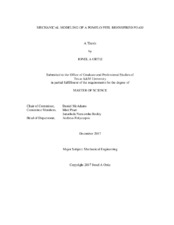| dc.description.abstract | Many naturally occurring structures have been shown to exhibit superior mechanical properties when compared to their constituent materials, such as the pomelo fruit, which, due to its hierarchical arrangement, allows the material to excel in both static and dynamic situations. For the case of the pomelo fruit (Citrus maxima) the peel has been shown to handle sudden shock and/or impact remarkably well, despite its relatively weak constituent materials. It has also been shown to exhibit a rather favorable quasi-static response with its high amount of energy dissipation. There have been many efforts to experimentally quantify aspects of the pomelo fruit along with interesting work taking place that ventures to fabricate biomimetic materials deriving from the pomelo fruit such as the utilization of a modified investment foam casting process to fabricate a foam-like material that resembles the mechanical structure of the pomelo peel. Little effort has been made to build mechanical models or finite element models that would allow users to tailor some aspects of the pomelo fruit peel to fit a certain need. The work presented here endeavors to define a feasible method that can be used to quickly build a finite element model using commonly known methods such as a Voronoi tessellation of space to construct the foam on a micrometer scale, while focusing on capturing the unique physics that are occurring due to the arrangement and structure of the pomelo peel. Using the network of beams, an input file can then be written that can be used with a finite element solver to quickly determine the response of the structure.
Of high importance was validating such a model with published literature, and upon completion a tool was made available that would enable designers to modify parameters such as the porosity of the structure at any given point, the cell count, material selection, etc. in a design scenario. The model was validated not only by having its mechanical response compared to the typical response of cellular materials, but was further validated when compared directly to compaction studies of the pomelo peel. | en |


